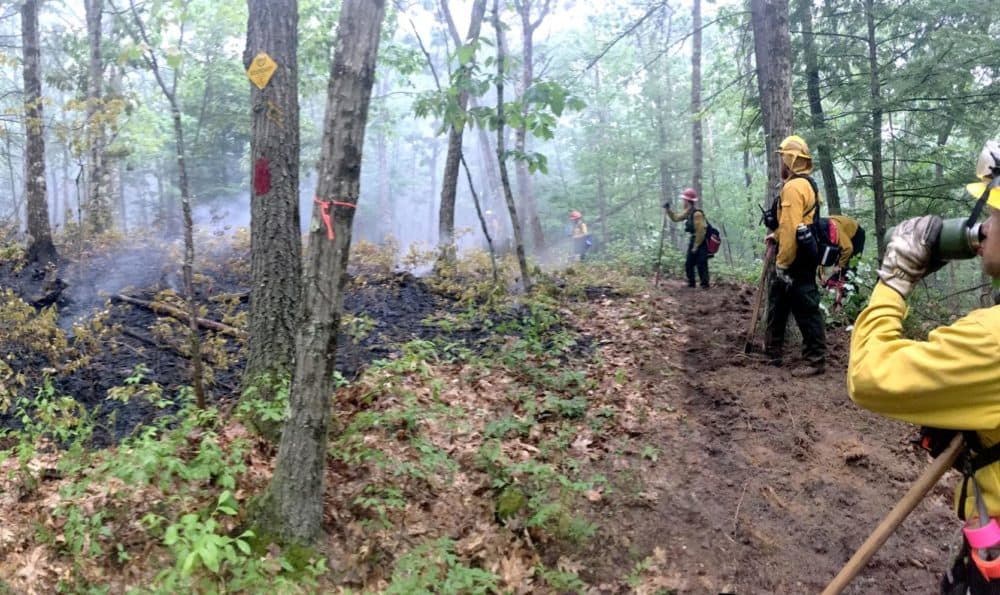Advertisement
Heat And Drought Cause 'Not So Normal' Fire Season In Mass.

While he was thinking through a descriptive title for a presentation on the state of Massachusetts' wildfire response, the state's forest fire warden David Celino batted around a few ideas before settling on one that got straight to the point: "2020 Fire Season: Not So Normal, exclamation, exclamation, exclamation."
Firefighters in Massachusetts have already seen two different wildfires burn for nearly a month each before they were declared to be over. The current drought in Massachusetts has contributed to risks for additional blazes, and fireworks activity has spiked dramatically over the course of the summer.
Add to that the ongoing COVID-19 pandemic, which has absorbed significant attention from fire departments and other first responders, and first responders are facing an unusual season.
"Nobody's ever gone through this, so it affects all programs," Celino told the Department of Conservation and Recreation's Stewardship Council on Thursday. "For us, we still have a mission to provide, especially when the same forces handed us a drought and a never-ending fire season as well."
The season in Massachusetts has been nothing like the massive wildfires raging in the western United States, where major metropolitan areas have been clouded by smoke and crews are stretched thin.
But there have been some notable blazes here among the 900-plus that DCR has recorded on more than 680 acres. A wildfire in Leverett's Joshua Hill area burned for 30 days before officials declared it expired, Celino said, while another in Copicut Woods near Fall River took about 28 days and a third on Tully Mountain in Orange ran for about two weeks.
Several incidents have been sparked by either lightning strikes, which are rare in Massachusetts, or by fireworks use. While Celino said he did not know how many forest fires could be traced back to fireworks, he said use of them — illegal for private citizens in Massachusetts — was "out of control" in 2020.
Another factor this season has been the weather. On Aug. 12, Energy and Environmental Affairs Secretary Kathleen Theoharides declared the entire state to be in a significant drought.
"We had multiple days of 90 degrees, which just drove the drought index up for us and really cooked those fuels that drive the fires," Celino said.
Celino's division also tracks dryness conditions based on a scale called the Keetch-Byram Drought Index, where a score of 100 represents "totally saturated" ground and 800 is "super, super problematic."
Different areas of the state currently reflect scores between 447 and 640, which is anywhere from 12 to 150 percent higher than last September, according to Celino's presentation.
"Once we go above 400, it's a real concern," he told the council. "It's going to mean that fires are going to burn deep, they're going to be hard to contain, they're going to be very labor intensive and dangerous for firefighter safety."
Like virtually every facet of public life, wildfire management — which at times promotes controlled burns as a way to improve ecosystem health and lower risks for uncontrolled blazes — has been disrupted by the COVID-19 pandemic.
While DCR is an available resource, all fires fall under the purview of local departments, even when they occur on state-owned lands.
"Here's the problem: our municipal fire departments are already stressed out and challenged by managing their missions under COVID-19, and we add drought-induced fire behavior to it," Celino said.
DCR stood up an expanded incident management team at the end of March to help responders balance fire and COVID concerns, tapping eight individuals who had already trained in relevant roles to take on more duties. That team is still operating today, Celino said.
His team also increased its communications apparatus, starting with once-weekly action plans that are now offered twice weekly to everyone in the bureau so they remain in the loop about ongoing threats and how to stay prepared.
"We're getting lessons learned coming in from around the country on incident management teams regarding COVID and wildland fires," Celino said. "Every person in my staff needs to know: what are the lessons learned and what are the watchouts for us here coming up in the next week?"
Looking to the fall, risks for wildfires could remain elevated if the drought conditions linger. In the 1990s, Massachusetts saw several autumnal fires of hundreds of acres each, which might serve as precedent, Celino said.
"What adds to the issue in the fall is that these trees start dropping their leaves. They already have under drought stress, and that adds fuel to the surface, fuels that are there, and then once the leaves drop, we lose the shading, which cools those fuels," he said. "The leaf litter will get drying effects from both underneath and above radiant sunlight, and that's just a double whammy of setting the fuels up to burn readily."